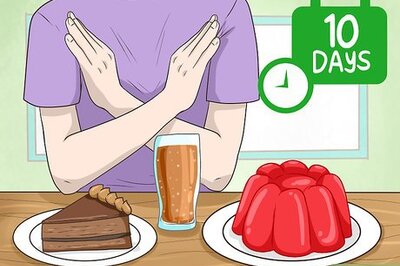
views
In 2011, he was termed as the 'last Gandhi' by his supporters and an enthusiastic media. But Anna Hazare, the same man in white dhoti and Gandhi cap, is not a charming figure any more, neither for the national media, nor for the opposition parties. The 82-year-old’s recent seven-day hunger strike at Ralegan Siddhi — his native village — did not get mass support like his revolutionary agitations of 2011 and 2013.
Hazare's hunger strike in 2011, followed by anti-corruption agitations across the country, was termed as revolutionary. Young and old alike had taken to Delhi’s Ramlila Maidan to show their solidarity with the octogenarian activist who they thought could bring about the much needed change in the country and slogans like ‘I’m Anna’, ‘Mai Hoon Anna’ became popular. In his report that year, BBC's Mark Dummett even called him the “new Mahatma Gandhi".
The same mass leader went on another indefinite hunger strike in 2019 for more or less the same demands. But the ‘Anna magic’ failed to make its mark this time. The social activist hasn’t changed in the past seven years and nor have his demands. So why then does he seem to have lost mass support in just seven years? This seven year story has got many folds and we tried to understand it by visiting Ralegan Siddhi.
Unfolding the Man Called Anna Hazare
Born as Kisan Baburao Hazare, Anna Hazare is a well-known figure in Maharashtra since the 1990s. He was regularly featured in the local media after he become a leading figure by bringing about social changes in Ralegan Siddhi.
The change began when in 1975 he took retirement from the Indian Army — where he worked as a driver — and returned to his village. During his career in the army, Hazare was posted at several locations and had close shave with death twice during an enemy attack.
"The military service and its experiences made me think deeply towards life and my aim of life was set there. I was highly inspired by Mahatma Gandhi's rural development philosophy and also by Swami Vivekananda’s literature," says Hazare.
His Journey Towards Gandhism
Hazare has not married and doesn't stay in his own house. He prefers living in a temple in Ralegan Siddhi. He himself had taken the initiative to build the temple Yadavbaba Mandir, which has been the centre of Anna movement since three decades. Hazare is staying there since 1975, while his two brothers stay in the same village in their ancestral home.
Hazare, while speaking to News18, declared: “Mi Fakir Manus — I'm a fakir with no ambitions or expectations. My sole aim in life is to serve the nation selflessly.” His sister-in-law Kantabai Maruti Hazare is proud to be his relative but said that she feels “very sad when he goes on fast. He is old now and we care for him."
His brother, Maruti Hazare, stays in a humble setup, which suggests that Hazare's fame brought no prosperity to his close family. The family members were never at the forefront of any of his movements.
The story of Ralegan Siddhi
Ralegan Siddhi, a small village about 80 km from Pune towards Aurangabad road, is known for and because of Anna Hazare. He was the driving force in transforming the once laidback drought prone village. It is now cited as the model village of Maharashtra with its effective water management, cleanliness system.
Liquor ban was the first movement Anna had fought for in this village. He then persuaded villagers to construct watershed embankment through shramdan. The water management system of the village is so perfect now that even during the drought year, there's enough water in reserve.
"I strongly believe in Gandhi ji’s vision of rural development and I still believe that we will bring the much needed change in the country. Urbanisation is not the solution,” Anna says.
‘Can Even Die for Anna’
Hazare’s village has been receiving visitors from across the globe since 1990s.
Hazare was honoured with Padma Shri in 1992 for his extraordinary model for rural development. His model has also been replicated in Hiwre Bazar — a village nearly 30 km from Ralegan Siddhi. Datta Aware, a villager who is in Hazare’s close circle, says, "When Anna gives a call for hunger strike, the whole village supports him without question. The villagers keep their kitchens closed during this period. We also fast along with him." When asked whether his ideas of Gandhism are still relevant to the villagers, they say, "Anna is much more for us... like a father figure for whom we can even die."
Jaisigh Mapari, sarpanch of Ralegan Siddhi, underlines, "We will continue to support Anna as one big family, come what may. There may be discordance on some issues, but Anna's calling brings us all together."
Struggle for RTI and Lokpal
He prompted the Maharashtra government to give a landmark decision devolving more powers to the gram sabha (village assembly) and Jan Lokpal Bill remained his prime focus since then. The credit of Right to information (RTI) Act also goes to the movement Hazare led in the 2000s.
His movement forced the state government to enact a revised Maharashtra Right to Information Act. This Act was later considered as the base document for the Right to Information Act 2005. From RTI to Lokpal, Hazare has remained at the forefront of civil rights movement.
Using Fast as a weapon
In accordance with Gandhian philosophy, Hazare considers hunger strike as the best weapon to highlight his demands. He has been using this weapon since the last 25 years. His fast against four corrupt ministers of Maharashtra in 2003 proved effective and jolted the then ruling government. He used this weapon against the Congress-NCP government in Maharashtra as well.
Emphasis on Society Rather Than on Politics
The octogenarian activist has never offered support to any political figure or party and says that he has no expectations from the politicians. "A change in government won't change the nation, but a change in system can change the nation. No political party can bring about such a change. So social movement needs to be stronger,” Hazare says.
Accusations of being pro-RSS
Hazare, who often asks the youth to follow Mahatma Gandhi's principles and even has a large photo frame of the legendary freedom fighter in his room, says, "I've never taken side of any political party in my life. I have never campaigned for or against any party." During the 2011 and 2013 anti-corruption protests followed by fast for Lokpal, Hazare was labelled as being anti-government. The BJP was in opposition then and social activist claims that the party took advantage of his movement. "The BJP used me", Anna had said during his latest protest. When asked how he felt when some people tagged him as pro-Narendra Modi or pro-RSS, he grins, "I have never had any affiliation with that organisation, but people wearing spectacles of a specific colour will see everything through that colour only."
Arvind Kejriwal and Team Anna
Hazare's social movement was limited to Maharashtra until Arvind Kejriwal and the others took it to a national platform. Close supporters of Anna still say that Kejriwal and others used Hazare for their own political innings as his movement got them the much desired popularity. Team Anna, led by Kejriwal, Manish Sisodiya, Kiran Bedi and others gained support from all sections of the society. Hazare himself didn't deny team Anna's contribution. "Team Anna was responsible for reaching out to the urban middle class, which till then had never participated in any movement," Hazare admits during the interview with News18.
He didn't allow Kejriwal to share the stage with him during the protest after Kejriwal entered active politics as Aam Admi Party leader. "Parties come and support me to gain political mileage. But I never invite them to share stage with me," he says.
Team Anna then and now
Anna’s team once consisted of socialists like G P Pradhan, environmentalists, educationists, journalists, academics, social activists like Yogendra Yadav and Medha Patkar and ex-bureaucrats like Arvind Kejriwal and Krian Bedi. No one from this team is beside him in 2019. Team Anna got scattered after 2013, and subsequently, Hazare started losing support of the middle-class that dreamed of a new India.
Now, there is no ‘Team Anna’ as such but only the close supporters who follow him in his movements. "There was no planning, no strategy this time and it was reflected in the first two days’ response to the agitations,” observes Sahebrao Kokne, a journalist who is covering Anna Hazare movement since the a decade. “Anna Hazare is losing ground because of his age, irrelevance and disconnect. This could be his last fast,” Kokne says.
Hazare was hailed as a revolutionary leader in the international media in 2011. Some sections of the media even compared Delhi's anti-corruption movement to Cairo's Tahrir Square movement. But the mass leader in the making couldn't keep that connect. "I could have campaigned in 2013 after team Anna split. The momentum should not have been lost. But I didn't have the money to travel and campaign. I'm a semi-literate villager who cannot reach to the height of Gandhi ji. I'm just a fakir," Hazare says.




















Comments
0 comment